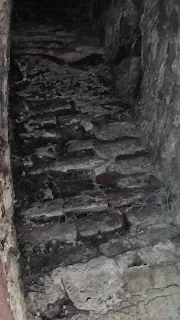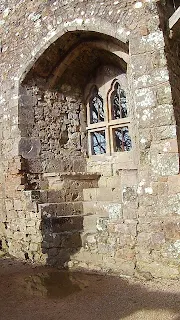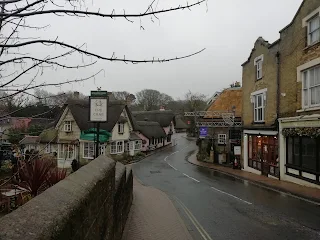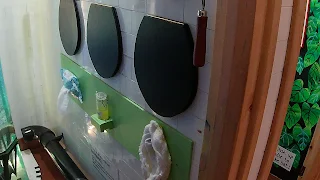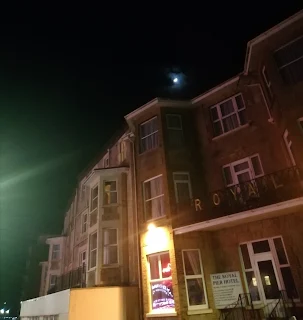Carisbrooke Castle dates from around 1100 and sits in the centre of the Isle of Wight, and although semi-ruined there are still some preserved buildings between its curtain walls. A Norman motte (mound) and bailey (enclosure) castle, it has commanding views, and because of the island's location has been of great importance in the defence of the realm.
Carisbrooke Castle succeeded a castle which dated back to the Norman invasion of 1066, and was built by Richard de Redvers, who was made lord of the Isle of Wight by Henry I (r.1100-35). The castle reverted to the crown when the last of that family died, in 1293. The castle has been used for defence; as a garrison; as a governor's residence and as a prison.
I have also created a YouTube vlog:-
We walked around its curtain walls; climbed the 71 steep steps up to the keep; learnt about King Charles I's escape attempts when he was imprisoned there and saw one of the castle's donkeys operating the well's treadmill.
Here's our view towards the imposing castle as we trudged up the hill.
The gatehouse has been the principal entrance to the castle for 900 years, and has been much modified during that time.
Inside the crumbling structure, and the gatehouse probably contained living accommodation for someone important.
Gun and medieval slit...
This metal staircase was once the entrance to the Isle of Wight Museum, which was founded by Princess Beatrice (Queen Victoria's youngest daughter) and housed here from 1898-1951.
The Chapel of St Nicholas, and this particular chapel dates from 1904. A chapel was first mentioned in the Domesday book of 1086, and a long sequence of chapels with the same name have since stood on roughly this spot.
The chapel serves as the Isle of Wight's war memorial, and the names of the 2000 island men killed in both world wars are inscribed on stone panels between the windows.
Painted reredos under fine stained glass windows, which show Christ surrounded by the two Marys, cherubim and angels.
The wagon roof consists of beautifully painted colourful panels.
This memorial bust of Charles I sits in the alcove at the west end, and is attributed to Italian sculptor and architect Gian Lorenzo Bernini (1598-1680).
Our first proper view of the castle complex...
The best part of the day was seeing their famous working donkeys. Here they are in their stable.
💓
There are currently six: Jester, Juno, Jigsaw, Jingles, Jack and Jill. The latter two are brother and sister...
The tradition of giving the donkeys "J" names has continued for the last 150 years. Apparently, when imprisoned Charles I wrote letters or planned his escape route he always signed his notes with a "J."
I have no idea which donkey is which, but they were all absolutely lovely.
😄
Training the donkeys how to work the treadmill takes up to a year and a half...
Donkeys were first recorded as being used to draw water from the well in 1696, although until 1880 only one was kept at the castle.
This is how you care for donkeys, if you are lucky enough to own them...
It was Jack's turn today, and here he is with one of his handlers. The talk she gave was very interesting- historically the poor beasts once had to work on the treadmill for up to 16 hours a day.
The courtyard well is 49m deep and holds water to a depth of 12m. It was dug after the well in the keep failed in 1136, and the treadmill used to raise the bucket was probably originally turned by prisoners.
Nowadays the donkeys are licensed to work for no more than six minutes a day...
Jack- who is known as the naughtiest (and most affectionate) of the donkeys is something of an escape artist, and will find his way out of anywhere you put him!
He successfully raised the bucket from the depths of the well.
💓
The gunpowder store...
The motte ditch beside the keep was once at least 4m deep and was infilled in the 14th century (possibly 1335, when other improvements were made to the defences).
The keep is accessed by 71 steep steps up the motte, and may have once been used as accommodation.
The keep was the ultimate refuge of the castle.
View down and you have to be careful ascending and descending these- whilst strong and sound, they are of varying heights.
This well appears to be original, and may be the failed well which ran dry in 1136. Water supply is a real problem on this chalk hilltop.
The well was dug to a depth of at least 48m- which is its current depth- to reach water.
Garderobe (that's a khazi to us modern day folk!)
View down from the curtain wall, and the fact that the well ran dry meant that Baldwin de Redvers (a supporter of Henry I's daughter, Matilda) had to surrender the castle to King Stephen in 1136, during the civil war of the time. His family did not regain control until 1153.
The view down the keep, overlooking the curtain wall.
View over Carisbrooke...
The SuperDean is the red figure at the end, and this view takes in Carisbrooke Cemetery.
The road we had walked up to access the castle...
The building at the back right houses Bowling Green Apartment, where you can stay. Prices start at £400 (low season) for a three night break.
From this height the castle grounds look like a little self-contained village! The well house is the dinky-looking building at the front of the photo.
You can see the stables from here, and opposite them is the south-east range, which nowadays houses the tea room and education centre.
Patchwork fields...
Village view and could that be the Solent in the distance?
Arrowloop. and this picture is simply perfect!
The Bowling Green was once earthworks outside the castle, added during refortifications in 1587...
Their purpose was to provide additional protection against gunfire.
It was refashioned into a bowling green to provide entertainment for the imprisoned King Charles I.
South-east bastion...
The cannon on the two bastions are 19th century naval guns, given to the castle in the 20th century.

North-east bastion.
The Princess Beatrice Garden, viewed from the curtain wall, and a better view of Bowling Green Apartment at the centre back.
After Henry's death in 1896, Beatrice succeeded him in this role.
Walking the curtain wall, looking down into Carey's Mansion. A kitchen once stood on this area.
George Carey was a cousin of Elizabeth I, and she appointed him captain of the island in 1583. He built his mansion to provide accommodation befitting his rank and household.
Built between 1584 and 1586, it is an extension and modification of the Constable's Lodging.
Carey remained captain until his death in 1604. Original fireplaces survive at both ends of what was once possibly a long gallery, used for exercise and recreation.
I just had to stick my head up the chimney!
The privy garden dates back to the 12th century. From the 17th century it was a garden for governors and captains, and became Princess Beatrice's private garden in 1913.
Princess Beatrice's husband- Prince Henry of Battenberg- was made governor of the island after their 1885 marriage.
This statue is by Philip Blacker, and shows Isle of Wight bred WWI General Jack Steely astride his horse, Warrior.
Little nook.
The last deputy governor of the island died in 1913, and Beatrice decided to take up residence at the castle.
Rickety stairs.
Up until then she'd been living above the Durbar Room at nearby Osbourne House.

More stairs which go nowhere!
Beatrice was in residence mainly in the summer, and this period is still remembered by some islanders.

The Edwardian-inspired garden as we see it was designed in 2009 and is based on the original layout.
The garden is divided into quarters with a fountain at its centrepiece, and plants which reflect the spirit of the ages.
Sometimes I can take a stunning photograph that's "just right." Now is one of those times, even with a SuperDean invading my shot!
A decorative palm tree, and Beatrice's standard flew over the keep when she was in residence for 25 years, until 1938.
Winter flowers, and Princess Beatrice died in Sussex in 1944.
King Charles I was brought here as a prisoner for 10 months, from 1647-48. He was allowed relative freedom at first, but then tried to escape three times. The second attempt would have been from this area, where bedrooms had been built by George Carey some 60 years earlier.
He was betrayed by his two guards- they had taken money to help him escape, and then cruelly turned him in.
This is Countess Isabella's window. Isabella de Fortibus was one of the greatest landowners in England at a time when it was uncommon for a woman to hold such power. As well as inheriting her husband's lands, she also inherited the estates of her brother, Baldwin de Redvers, and held on to everything- including this castle- until her death, in 1293, when she sold her lands on to Edward I.
She made many transformations to the castle including this great chamber for herself. It had glazed windows; a luxury at the time.
The Carisbrooke parish gun dates from 1549 and is displayed at the museum door. Each parish had a gun like this for defence purposes.
Since 1951 Carisbrooke Castle Museum has sat in what was once the Great Hall, and the Lower Gallery is devoted to the history of Carisbrooke Castle.
Here is a model showing what the castle once looked like.
William de Montacute was the Earl of Salisbury, and lord of the island from 1386-97. This fireplace is the main surviving medieval feature in the hall, and was inserted by him.
The gallery tells the story of the castle through six of its most famous residents. This cabinet is devoted to George Carey.
Walking stick in Charles I's cabinet...
Plaster maquette of the Princess Elizabeth monument. She was Charles I's daughter, and she was brought here in 1650 following his execution. She died aged 14, only weeks after her arrival, from a chill.
Henry, Duke of Gloucester, Charles's third son was also brought here. He was 10, but was allowed to join his family in exile in 1653.
The Old Staircase leading to the Constable's Solar in the attached Constable's Lodging. The constable was an important administrative official.
These delightful little fellows are gargoyles taken from a local demolished church...
Beautiful stained glass as we approached King Charles' Bedroom.
Once the Constable's "solar"- a private apartment away from the bustle of daily life at the castle- it became the room King Charles made his first escape attempt from.
The King's bed would have looked something like this...
On the night of March 20th, 1648 he attempted to shimmy through this window, but became wedged between the bars!
The Ashburnham Collection sits inside a room just off this, with objects passed down through the family of John Ashburnham. He was a loyal and most trusted courtier and treasurer, and was paymaster of the King's army during the English Civil War.
A locket containing a piece of King Charles's hair, encased in a glass and gold pendant. It was taken from his coffin when his tomb was excavated and his body exhumed, in 1813.
This room houses some of the King's personal possessions- including rare surviving examples of early Stuart court textiles- which he used until his execution.

King Charles I (1600-49) was beheaded at the Palace of Whitehall, London.

This Upper Gallery section is called Island Stories.
This is a Roman Janus Head, with two faces looking in opposite directions. He was worshipped at "beginnings" (weddings, births, planting, etc.)
I just thought the facial expression resembled me in a bad mood!!!!
This cabinet is dedicated religious life.
Toys...
Wartime...
School days...
Contemporary collecting...
Victorian dolls' house...
Of course, being a shoe fetishist, I just had to take a photo of the shoe cabinet!😉
The museum contains a room full of pictures of local places. The Needles are three stacks of chalk which raise out of the sea at the furthermost western point of the island.
We didn't go- it was a hell of a distance to get to on the bus and the viewing chairlift was not open when we were there.
Appuldurcombe House is a partially restored house shell which was also not open during our visit.
Oh well- maybe next time!
We did go to Osbourne House- Queen Victoria's island hideaway. I'm not sure if I'll be blogging about it- whilst my outside photos came out okay, my inside pictures were lacking, and you can't visit the bedroom section of the house in winter anyway.
Oh well, I'll just have to return...😁
We had some dreadful weather in the Isle of Wight! On the wettest day we took the bus just up the coast to Shanklin, as we've stayed in the area before.
Here's a photo looking down into the Old Village; past The Crab Inn, The Old Thatch Teashop and King Harry's Bar.
Vernon Cottage has a lovely beer garden, which we have been to on a much nicer day.
The building looks like something out of a fairytale!
We ate at Tommy Bradshaw's Bar and Bistro 14 years ago (I remember having a fishy on a fish-shaped dishy!) but it wasn't called that then. We popped in for a G&T and shelter from the rain.
Overlooking Daish's Hotel which I remembered, and it was my landmark for locating the restaurant/ bar we'd eaten at before.
Hotels overlooking the Solent in Ryde, where both the ferry and hovercraft arrive/ depart.
Ryde Pier is the second longest seaside pier in the country (shorter only than Southend Pier), at 1,740 feet. It opened in 1814 and reached its present length by 1842.
Our hovercraft, taken in Portsmouth as we waited to depart.
It was the first time I'd been on a hovercraft!
Our hovercraft in dock after our arrival, taken from Ryde Pier.
Isle of Wight, I have plans to return for work (blog and vlog) purposes.
Until then,
TTFN
Miss Elaineous
XXXXXXXXXXXXXXXXXXXXXXXXXXXXXX
XXX
X
.jpg)
.jpg)



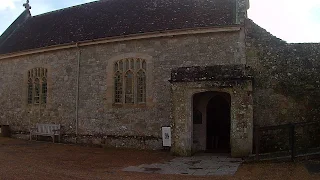




.jpg)
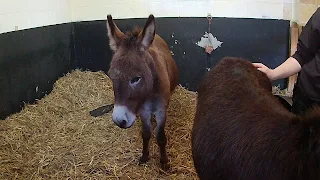






.jpg)
.jpg)



















.jpg)
.jpg)









